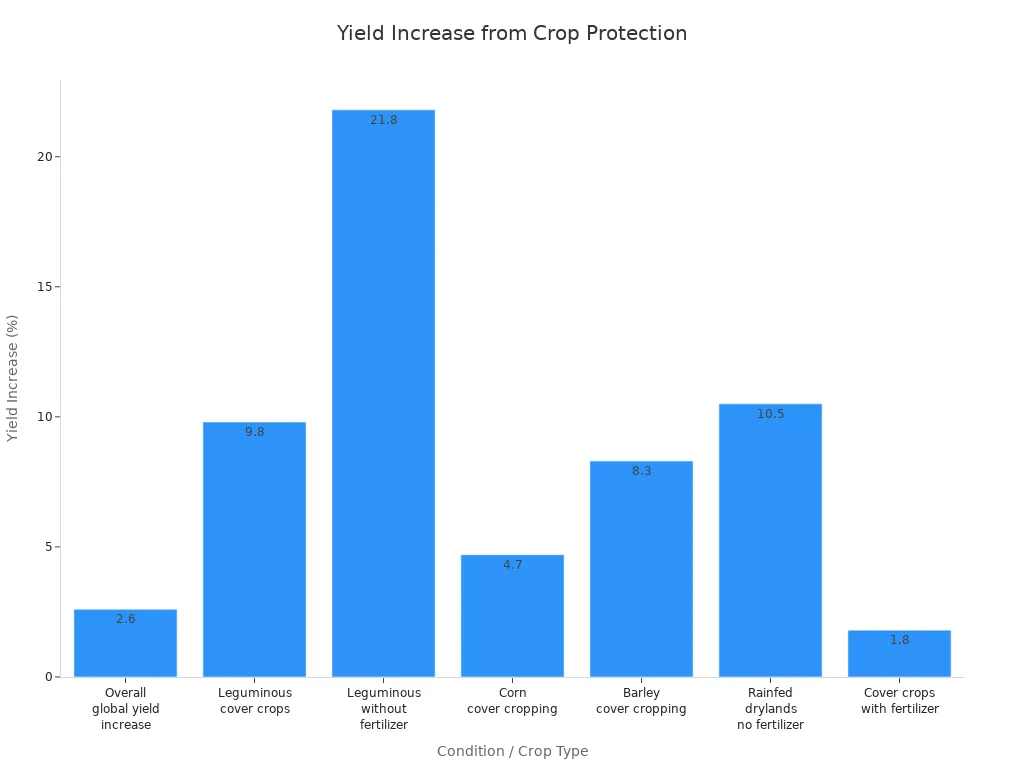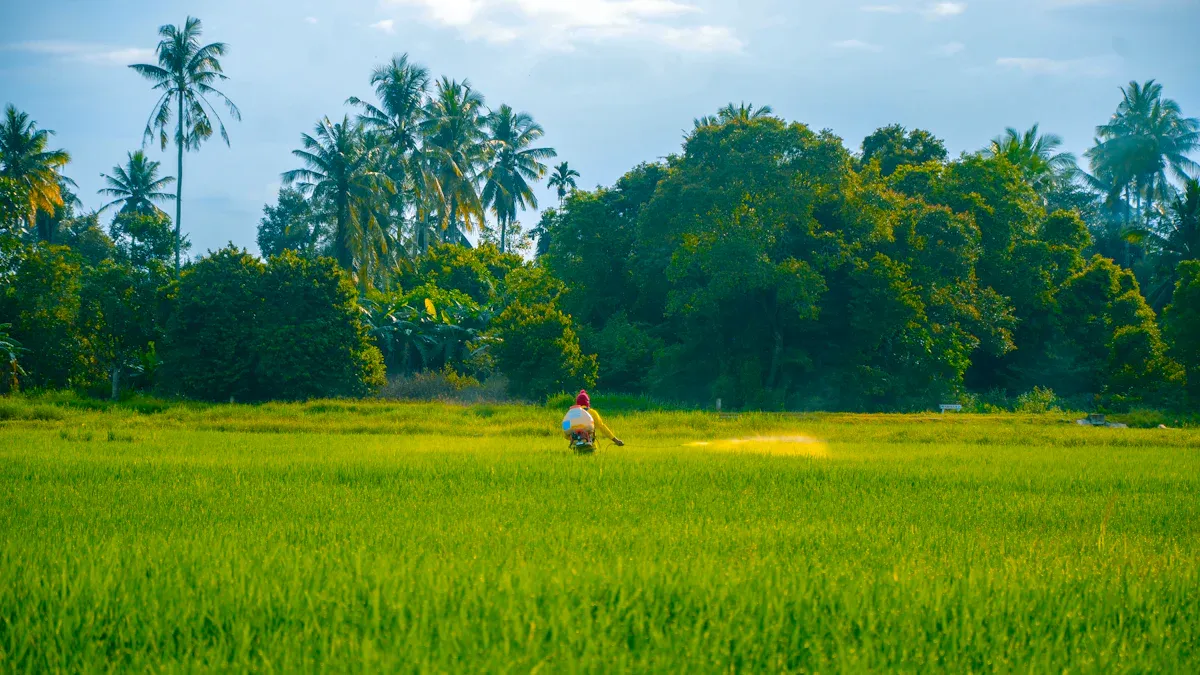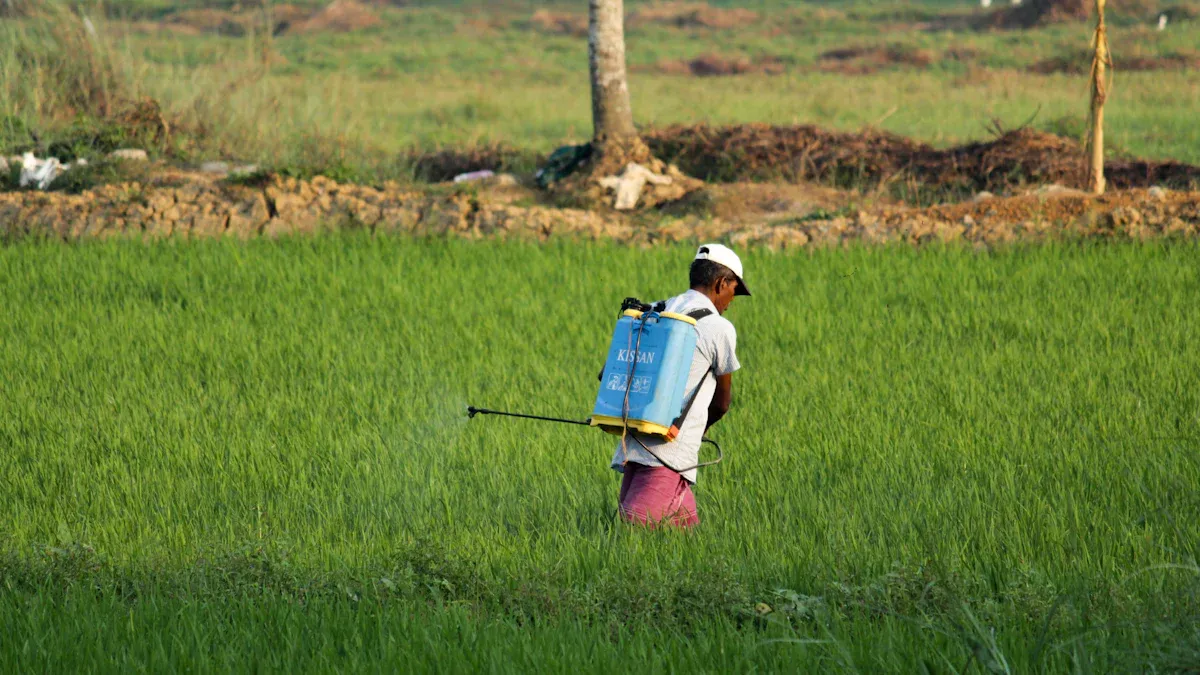Views: 0 Author: Site Editor Publish Time: 2025-08-05 Origin: Site










You can see a big change when crop protection works. Your crops look healthy and you get good harvests. You use different methods and plan your work well. These actions help keep your plants safe from pests. Check the numbers below. Cover crops can help crops grow better. For example, legumes can grow 21.8% more without extra fertilizer.
Condition / Crop Type | Yield Increase (%) |
|---|---|
Overall global yield increase with cover crops | 2.6 |
Leguminous cover crops (peas, vetch, clover) | 9.8 |
Leguminous cover crops without fertilizing main crops | 21.8 |
Corn (under cover cropping) | 4.7 |
Barley (under cover cropping) | 8.3 |
Rainfed drylands without fertilizer | 10.5 |
Cover crops with fertilizer | 1.8 |
Coarser soils (sandy loam, loamy sand) | Positive yield impact |
Fine-textured soils (clay-loam, clay) | Negative yield impact |

When you use integrated crop protection, you help feed more people. You also help keep food safe for everyone. This way uses fewer pesticides and is better for the earth. It needs good rules and smart choices from farmers like you.
Crop protection methods like crop rotation and cover crops help plants stay healthy. Scouting also helps. These methods can make crops grow better and give more food.
Integrated crop protection uses many tools together. This helps use less pesticide. It saves money and keeps the environment safe.
Scouting helps find pests and diseases early. This means farmers can act fast. Acting fast gives better harvests and costs less.
Farmers face problems like pest resistance and climate change. They need to make smart choices. They use new technology and work together.
Sustainable practices and weather-based plans help farmers grow more food. These ways also protect the earth for the future.

You want your crops to look strong and full of life. Crop protection helps you reach this goal. It uses many methods to keep pests and diseases away. You can rotate crops, mulch the soil, or use helpful insects like ladybugs. These steps lower the need for chemicals and keep your plants healthy. When you choose resistant crop varieties, you stop diseases before they start. Healthy crops give you better nutrition and higher market value. Scientists found that crops grown in rich, natural soil have more vitamins and minerals. Good postharvest care, like sorting and storing, keeps this quality high. You can even grow traditional crops, such as millets, to boost nutrition and profit.
You work hard each season and want steady results. Crop protection gives you more stable yields. It cuts down losses from pests and diseases. Studies show that, without crop protection, pests can destroy up to 80% of some crops. When you use these practices, you lower losses to about 26-40%. This means you get more food from the same land. Machine learning models show that crop protection leads to steady yields year after year. Stable yields help you plan better and avoid big losses. They also support rural economies:
You get steady income.
You can invest in new tools and technology.
Your community grows stronger as farms succeed.
You help feed your family and your community. Crop protection plays a key role in global food security. It stops pests and diseases from wiping out harvests. Each year, pests threaten up to 40% of the world's food production. Crop protection keeps more food in the supply chain. This supports a safe food supply for everyone. It also helps countries meet the needs of a growing population. Modern methods, like plant breeding and biocontrol, make food production more reliable. International teamwork helps stop pests from spreading across borders. When you use crop protection, you support sustainable food production and help secure the world's food supply.

Crop rotation is a helpful way to protect crops. Changing what you plant each season stops pests and diseases from growing. For example, switching between corn and soybeans lowers corn rootworm numbers. This also makes the soil better, so plants can fight off problems. Studies show crop rotation can cut pest outbreaks by half. It can also lower soil diseases by about one-third. Using this method means you need fewer crop protection products. This helps you save money on things you buy for your farm.
Benefit | Description | Estimated Impact (2025) | Relevance to Sustainability |
|---|---|---|---|
Pest Reduction | Stops pest cycles by removing host crops. This lowers crop pests and reduces pesticide use. | 20–50% fewer pest outbreaks reported | Helps with eco-friendly farming and pest management |
Disease Control | Breaks disease cycles by removing host crops. This reduces soil-borne pathogens. | Up to 32% reduction in soil-borne disease incidence | Lowers fungicide use and keeps soil and crops healthy |
Tip: Try rotating crops like wheat, corn, and legumes. This keeps your soil healthy and your fields working well.
Cover crops give you lots of crop protection benefits. You plant them between main crops to cover the ground. They stop weeds from growing by blocking sunlight and taking up space. Many farmers see fewer weeds after using cover crops. For example, winter rye can lower weed seeds, even tough ones like waterhemp. Cover crops also make the soil better, stop erosion, and help keep water in the ground.
Cover crops bring in helpful insects that eat pests.
They give food and shelter to ladybugs and other good bugs.
Some cover crops, like mustards, can lower soil diseases and nematodes.
Over 90% of farmers use cover crops for soil health, and almost 80% use them for weed control.
Note: Letting cover crops flower brings more good insects. This helps you control pests without extra crop protection products.
You need to know what is happening in your fields. Crop scouting helps you find pests, diseases, and nutrient problems early. You can walk your fields, use traps, or take soil samples. Today, you can also use drones, satellites, and digital tools to check crops. Finding problems early lets you act fast and use the right solutions. This saves money and keeps your yields high.
Scouting often means you use fewer crop protection products.
You make better choices about when and where to spray.
You help stop pests from becoming resistant to treatments.
Scouting at different crop stages gives the best results.
Farmers who scout often get higher yields, healthier crops, and lower costs.
Seed treatments protect your crops from the very start. You coat seeds with fungicides, insecticides, or biopesticides before planting. This keeps young plants safe from soil pests and diseases. Seed treatments use much less active ingredient than spraying. This means less harm to the environment. Biological seed treatments are even safer for nature and other living things.
Aspect | Seed Treatments (General) | Biological Seed Treatments / Biopesticides |
|---|---|---|
Active Ingredient Usage | Use about 10% of active ingredient compared to spraying. | Usually lower, and come from natural sources. |
Crop Safety | Protect seeds from pests and diseases without hurting them when used right. | Very safe for seeds, with little risk of harm. |
Environmental Impact | Less exposure to other living things; less pollution. | Even more friendly to the environment; little effect on other species. |
Sustainability Benefits | Need fewer chemical sprays, use less fuel, and lower carbon footprint. | Help sustainability because they are natural and specific. |
Seed treatments are a normal part of crop protection and are often needed for crop insurance.
You get the best results when you use many crop protection methods together. Integrated crop protection, or Integrated Pest Management (IPM), uses different tools at once. You watch your fields, set action points, and only use products when needed. This way, you use fewer pesticides, save money, and help the environment.
IPM keeps good insects safe and slows down pest resistance.
You use natural pest control, like ladybugs or biopesticides, with other methods.
Technology, like GPS sprayers and AI scouting, helps you treat only where needed.
You keep records and pick the safest options first.
Integrated crop protection helps you manage pests, protect your yields, and keep your farm healthy.
You have many ways to protect your crops. By mixing crop rotation, cover crops, scouting, seed treatments, and integrated plans, you build strong defenses. You protect your farm, your money, and the environment for the future.
Pest resistance is a big problem for farmers. Sometimes, pests get used to crop protection products. Then, the products do not work as well. This makes it harder to keep crops safe. The EPA watches for pest resistance and asks for reports. You can slow resistance by using smart steps. First, check pest numbers before you spray. Only spray when you really need to. Next, switch between different pesticides. This helps stop pests from getting too strong. Use integrated pest management to mix natural pest control, crop rotation, and good timing. Leave some areas unsprayed so pests do not all become resistant. Write down what you use and when you use it. Herbicide-resistant weeds are spreading quickly. No new herbicide types have come out for many years. You must use many methods and stay alert to protect your crops.
Weather changes bring new problems to farms. Hotter days, less rain, and sudden storms can hurt crops. Pests and diseases move to new places and get harder to stop. Old ways may not work as well now. You can adapt by trying new things. Grow different crops and raise different animals to lower risk. Use tools like GPS tractors and drones to help you farm better. Plant cover crops and rotate crops to keep soil healthy. Save water with drip irrigation and collect rainwater. Pick crop varieties that can handle heat and dry weather. Farmers in many places use these ideas now. They also join groups to share tips and get weather news. You can make your farm stronger by learning and trying new ways.
Farmers must follow many rules to protect crops. Governments set strict limits on chemicals. They want food to be safer and the environment cleaner. There is more focus on using biopesticides and integrated pest management. Rules also ask for better data privacy and safe transport of products. Countries work together to make rules the same. This helps with trade and keeps food safe. You need to keep up with new rules to stay in business and protect your land.
Regulatory Trend | Impact on You |
|---|---|
Stricter chemical limits | Fewer product choices, safer food |
Push for sustainability | More use of eco-friendly practices |
Faster product approvals | Quicker access to new solutions |
Data privacy rules | Careful handling of farm information |
Global rule harmonization | Easier trade, clear safety standards |
Keep learning about new rules. They help you farm safely and protect farming for the future.
Every year, new tools help you protect crops better. Smart irrigation systems use sensors to give plants enough water. This saves water and keeps crops healthy. Blockchain helps you follow food from the farm to the store. This makes food safer and easier to trust. Digital twins let you see a virtual copy of your farm. You can find problems early and make good choices. AI and machine learning help you guess when pests might come. They also help you know the best time to plant or water. Farm management systems use maps and data to help you work faster and get better results.
Vertical farming lets you grow crops in cities all year.
Biopesticides from nature target pests but do not hurt the environment.
Genetic modification makes crops stronger against pests and diseases.
These new ideas help you grow more food and use fewer resources.
You help protect the earth while growing food. Sustainable crop protection means using fewer chemicals and more natural ways. Integrated Pest Management mixes different ways to control pests. You do not have to use just one method. This keeps the environment safe and helps you grow healthy crops. Many countries have laws that support IPM and other green ways. You use tools and research to spray only when needed. This keeps water clean and helps wildlife. Sustainable agriculture helps you meet needs now and in the future.
Practice | Benefit |
|---|---|
Integrated Pest Management | Less chemical use, safer environment |
Biopesticides | Lower risk to people and animals |
Crop rotation | Healthier soil, fewer pests |
Decision support tools | Smarter, timely crop protection |
Weather changes every season, so you need to be ready. Now, you can use weather data to make better choices. Weather stations and satellites give you updates on rain, wind, and temperature. Decision Support Systems use this data to tell you the best time to spray or plant. AI looks at weather, soil, and crop data to help you plan ahead. You get alerts on your phone about storms or frost, so you can act fast. These tools help you protect crops before problems start.
Change how much you water based on rain predictions.
Plant at different times if frost is coming.
Watch for pest risks when it gets more humid.
Weather-driven strategies help you stop problems before they start. You save money, use fewer chemicals, and grow more food. This keeps food production strong, even when the climate changes.
You see the results when you use effective crop protection. Your crops stay healthy, and your yields remain steady. You help create a safe food supply for everyone.
You need new ideas and quick action to keep up with changes.
You work best when you join with other farmers, researchers, and leaders.
Together, you can build a future where crop protection supports strong farms and healthy communities.
Integrated crop protection means you use many methods together. You combine scouting, crop rotation, and natural enemies. You use chemicals only when needed. This approach keeps your crops healthy and helps the environment.
You should scout your fields at least once a week during the growing season. Early detection helps you act quickly. You can use tools like drones or apps to make scouting easier.
Cover crops protect your soil. They stop erosion and add nutrients. They also help control weeds and pests. Many farmers use cover crops to improve soil health and boost yields.
Tip: Let cover crops flower. Good insects will visit and help control pests.
Method | Cost Savings | Extra Benefits |
|---|---|---|
Crop Rotation | High | Better soil, fewer pests |
Cover Crops | Medium | More nutrients |
Scouting | High | Early problem detection |
Crop rotation and scouting often save the most money. They also keep your farm strong.